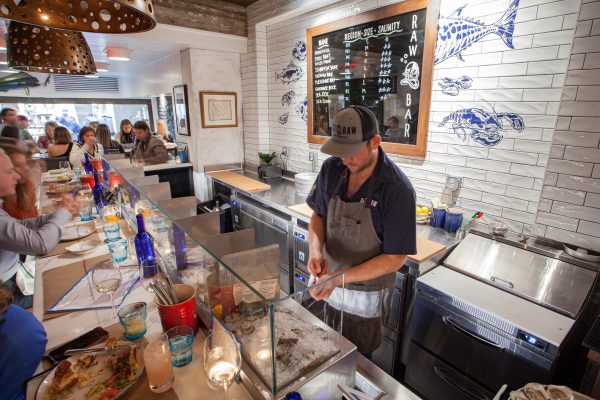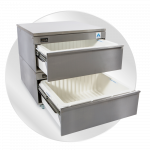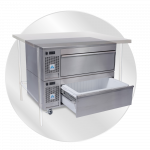Russell Stilwell
Featured above is one of the exclusively designed concepts by well-known US hospitality consultancy firm Next Step Design. In an exclusive interview, we catch up with its founder, Russell Stilwel who shares with us his views on the hospitality industry, his thoughts on kitchen design, Adande fridges, and talks to us about his vision for the future.
Russell Stilwell is the Founder and Principal of foodservice consultants, Next Step Design, which he established 35 years ago. As a youngster he relished dining at fine restaurants, ordering delicacies while his siblings settled for hamburgers. Captivated by the kitchen environment, he started work as a dishwasher at the age of 13, before obtaining a degree from the Culinary Institute of America. He then worked himself up to sous chef.
During his time working in food preparation, Russell began to question the function and flow of kitchens. He took up a role at LeBow Restaurant Equipment Co., where he quadrupled sales and established a reputation for innovative design, eventually becoming it’s owner. In 1987 Russell decided that the way forward was for an independent consultancy, which designed and specified kitchens, but did not purchase the equipment and Next Step Design was born.
Today, the company is one of the largest foodservice consultants in the USA, operating across North America. It has its headquarters in Annapolis, with satellite offices in New York, Seattle, El Paso, and Ottawa, employing almost 50 staff.
What is Next Step Design’s business ethos?
We approach every design project from a holistic perspective, believing that foodservice is the engine that drives the energy and attitude of a space. Our designs are never just a series of calculations, because we speak the language of the foodservice industry and live within its culture. The visionaries behind the country’s most luxurious restaurants, hotels, and workplace dining experiences trust us absolutely. They know that we create a higher level of foodservice design that empowers the chefs, optimizes productivity, excites our partners, and wows the patron. At Next Step Design we consider ourselves a family, we care about the team and in turn the team cares about our product and our clients. We provide the most detailed documents in the industry, and we do it with integrity, creativity, and passion.
What are the core markets for your consultancy services?
Nearly 60% of our projects are high-end, independently owned restaurants and hotels. We also design kitchens for transport terminals, entertainment venues, workplace catering, educational/institutional establishments, quick service restaurants, food halls and commissaries.
What is your key piece of advice to clients?
A healthy collaborative culture is a very important aspect of any kitchen design project. For any given assignment, we may be working with a combination of owners, architects, developers, equipment manufacturers, and project management groups. Success is dependent upon ensuring that all these parties are team players and have the same goals.
What are the driving factors in kitchen design?
The design of a kitchen is dictated by menu concepts, the sort of catering operation, and the method of service. Clearly the requirements of a kitchen at a banqueting venue will be quite different to those of a QSR. The hallmark of a well-planned kitchen is having everything at your fingertips – you don’t want to have chefs leaving their workstation to fetch equipment or ingredients. It is also important to have complete control over the efficient flow of food: from goods inwards, to storage, to preparation, to cooking, to service. In recent years, there has been a trend towards open kitchens, where the food preparation area becomes integrated with the dining area. This makes it even more important for our design to be functional and attractive.
How important is sustainability in the North American hospitality industry?
If I’m honest, North America has been fairly slow to embrace sustainability, especially in comparison to most Western European countries. However, environmental responsibility is now very much on the agenda and rising energy costs will encourage operators to look at more efficient kitchens. We have already witnessed a trend away from gas appliances.
It is written into all Next Step Design contracts that, whenever possible, we will specify the most energy and resource efficient equipment. We are committed to working with clients and equipment manufacturers to encourage sustainable solutions, energy-saving products, and business practices. In the long term, we know energy-efficient operations not only have a positive impact on our clients’ profits, but also help reduce energy consumption and cut carbon emissions. Since commercial kitchens are one of the most energy and resource intense areas of any hospitality project, our standard design includes the most efficient equipment for water, ventilation, and refrigeration. Ultimately, we draw on the expertise and experience of our team, to ensure and implement innovative sustainable designs. These initiatives have been welcomed by our clients.

What are the challenges facing today’s hospitality industry?
The COVID-19 pandemic had a significant effect on restaurants and public dining spaces. In most of the States lockdown measures meant that foodservice operations were unable to serve eat-in diners. Even after lockdown measures were relaxed, social distancing caused restaurants to operate with reduced capacities. While some forward-thinking businesses adopted initiatives such as takeaway food and outdoor dining, the pandemic substantially reduced the revenues of the hospitality industry. Although life is now pretty much back to normal, losses incurred during the COVID-19 era will have made a lasting impact on many foodservice businesses.
The pandemic was also a headache for Next Step Design. As hotels and restaurants closed and new projects were put on hold, demand for our consultancy services reduced dramatically. I am pleased to say that we are now back to pre-pandemic business both in terms of projects and staffing levels.
Although rising energy costs and supply chain difficulties have not yet bitten into the North American hospitality market, I foresee these as being the next challenges to our industry. Higher costs will inevitably increase the cost of eating out. The hike in the cost of living will mean that ordinary people will have less money in their pockets to spend on entertainment. Only time will tell whether reduced disposable incomes and higher dining out costs will negatively affect trade in restaurants and foodservice operations.
What does the future hold for Next Step Design?
We have a young and diverse team, showing passion for the company and the industry. I give them every opportunity to grow their careers and develop the business. Several of them have the ability and hunger to work their way to the very top and one day run the company. We currently have plans to open branches in new locations to further increase the number of kitchen design projects we undertake and grow the business. It is all part of my transition plan, which will allow me to eventually retire with some degree of comfort.
How did you discover Adande?
Our manufacturer representative introduced me to the Adande fridges about six years ago. On a subsequent visit to the UK, I met up with Adande’s Global Sales Director, Karl Hodgson, who explained the concept and highlighted the benefits of the horizontal insulated container technology. I was very impressed, and I have been specifying Adande fridges for the last five years. I have been spreading the word amongst my colleagues and the industry, who have been supportive of the Adande brand. The drawer design has several advantages over conventional fridges with doors and Adande is now the ‘go to’ solution for many of our projects, especially those which require the holding of food at critical and accurate temperatures.
What benefits do Adande units offer?
Adande fridges are designed to be positioned at the point of food preparation, cooking, and service. This means that all of the ingredients are at the chef’s fingertips, eliminating the need to leave the workstation to fetch items from remote fridges. This speeds up service, especially during busy trading periods. The Adande units offer a different and more efficient approach to mise-en-place.
Standalone or undercounter Adande units are space saving solutions, which free up valuable kitchen floorspace for additional equipment. The fact that the Adande has its refrigeration machinery located at the rear of the unit means that we save one linear foot of floorspace per module, compared with similar fridges. The units have a large capacity relevant to footprint, meaning that fewer refrigeration units are required for the same amount of storage, reducing capital costs, and taking up less floorspace.
Adande fridges are inherently versatile compared with conventional refrigeration. The independent control of the temperature of each drawer, through a range of -7.6°F to 59°F, is a key feature of the product, providing the capacity for chilled and frozen storage in the same unit. This allows the storage of a wider range of ingredients at the point of food preparation. The dual temperature capability means the fridge’s temperature can be adjusted for different ingredients for specific service periods, such as breakfast, lunch, and dinner. The fact that temperature can be regulated accurately in 0.1°F increments is particularly useful for niche foodservice operations, where product temperature is critical. Sushi bars are a prime example.

And what about the performance of the Adande?
The horizontal container design and humidity of the Adande system deliver accurate and stable temperatures. Food is held at optimum appearance and quality for longer, even in the hottest kitchens. One of the problems associated with conventional freezers is temperature fluctuation when the door is opened frequently or left open accidentally, which can compromise product quality and appearance, causing food waste.
We understand that Adande units use at least 40% less energy than comparable fridges, which fits in with our commitment to specifying the most sustainable equipment available. Our clients have been impressed with the efficiency of Adande and as energy costs continue to rise, this will become an increasingly important factor in choosing refrigeration solutions.
Kitchens can be very demanding environments with equipment being subjected to some rough treatment. The Adande modules are solid and robust and are designed to withstand the knocks and bangs which inevitably occur in a busy kitchen.
Refrigeration reliability is a major issue in hospitality as downtime may result in food waste or lost sales. Statistically, the product has a very low failure rate, and I don’t think we have ever received a maintenance call for an Adande fridge.
What about cleaning?
Hygiene and food safety are critical issues in our business. The Adande drawers are fully removable meaning that cleaning is quick and simple. The stainless-steel exterior is also easy to wipe down as part of a regular housekeeping regime. caster mounted units may be moved, so that areas behind the fridge can be cleaned regularly and thoroughly.
If you had not joined the foodservice sector, what might have been your career path?
I think it was inevitable that my career would be in the foodservice industry. If I hadn’t chosen the consultancy path, I like to think that I would have become
a chef in a high-end restaurant.
Writing fiction might have been another possibility and is something I may pursue in my retirement. I have met so many larger-than-life people through work, who would make excellent characters for a novel based around the hospitality industry.
Tell us about your home and family?
I live in Annapolis, within walking distance of the office, so I don’t have the problem of a long commute. I spend at least ten hours a day at work, so time at home with my wife of nearly 40 years, Cynthia, is a great way to relax. Typically, Cynthia will cook dinner and we will enjoy a couple of glasses of wine with our meal.
Family life is very precious to me. I have two daughters, Maggie and Brittany, as well as a son, Chad. They are all now grown-up and have fled the nest. It doesn’t happen as often a I would like, but one of my great joys in life is when my kids, their spouses, and the grandchildren visit, and we all sit around the table for a formal Sunday meal. It is an atmosphere which fills me with love and pride.
Does your passion food extend into your personal life?
Cynthia and I aim to dine out at least twice a week. We usually opt for high-quality food at fine dining establishments or independent bistro style restaurants. We never eat at chains or QSRs.
I am particularly keen on eating at venues where Next Step Design has specified the kitchen. Part of the attraction is seeing how the live kitchen works and a feeling of loyalty towards my client, but the main reason is that I like to spend my money where I made it.
Do you have any interests outside of the hospitality industry?
I am a keen follower of the English Premier League and passionate about Liverpool Football Club. I try not to miss a televised match and I even have a TV in the office, so that I can watch games during working hours with the volume turned down. Liverpool’s performances this year have been quite remarkable and very enjoyable to watch. I have been to see Liverpool live at the Anfield stadium three times, one of which was with Adande’s Global Sales Director, Karl Hodgson. On each occasion the atmosphere created by the team’s loyal fans has been amazing. Anfield is a very special place.
I like to keep in good shape, so I go cycling regularly. I have recently returned from a group cycling tour of Majorca, Spain. I went with some old friends and made some new friends during the trip. The tour was sponsored by my local cycle store, and we rode 40 to 50 miles a day. The cycling and camaraderie were great, and we also ate at some excellent traditional restaurants, serving authentic rustic food.
I have competed in several Metric Century cycling events, which are over a course of 100 km or approximately 62 miles. I have taken part in Metric Century contests in Little Rock, Chicago and closer to home in Maryland. We also took part in a Metric Century event during our recent tour to Majorca.





